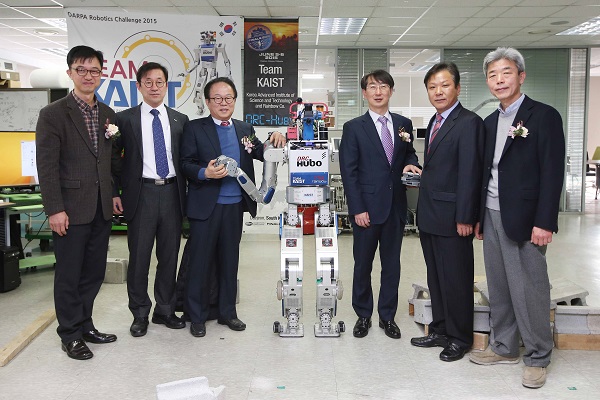policy

(Photo from left: Kyong-Hoon Kim from Korea Evaluation Institute of Industrial Technology, Vice President of Research at KAIST Hee-Yoon Lee, Director Oh, Jong-Hwan Kim at the Ministry of Trade, Industry and Energy, President Ki-Han Park at the Korea Institute for Robot Industry Advancement, and Dean of KAIST Institute Yun Chol Chung.)
KAIST opened its Humanoid Robot Research Center on January 19 at the KAIST Institute. Endorsed by the Ministry of Trade, Industry and Energy with 15 billion KRW funding over five years, the center will conduct research for advancing humanoid robot technology and fostering research fellows in the field.
Professor Jun Ho Oh at the Department of Mechanical Engineering will serve as the director of the center. Team KAIST under Professor Oh won the 2015 DARPA Robotics Challenge (DRC) with its humanoid robot DRC-HUBO, beating 23 teams from six countries.
Professor Oh said, “I believe we have already achieved technological prowess through developing the HUBO robot over the past decade. The center will continue to strive for further development of original technology crucial for humanoid robots’ key components. We want to pave the way for having enough of our own technology and needing to bring in technology from abroad. Professor Oh said he will focus on fields such as high-efficiency, high-powered electric drives and hydraulic system humanoid robot capable of executing solid manipulability with high confidence and object recognition intelligence technology. In addition, he said the center will develop module type and extended open software in an effort to disseminate robot technology.
-
research KAIST Develops Retinal Therapy to Restore Lost Vision
Vision is one of the most crucial human senses, yet over 300 million people worldwide are at risk of vision loss due to various retinal diseases. While recent advancements in retinal disease treatments have successfully slowed disease progression, no effective therapy has been developed to restore already lost vision—until now. KAIST researchers have successfully developed a novel drug to restore vision. < Photo 1. (From left) Ph.D. candidate Museong Kim, Professor Jin Woo Kim, a
2025-03-31 -
research KAIST provides a comprehensive resource on microbial cell factories for sustainable chemical production
In silico analysis of five industrial microorganisms identifies optimal strains and metabolic engineering strategies for producing 235 valuable chemicals Climate change and the depletion of fossil fuels have raised the global need for sustainable chemical production. In response to these environmental challenges, microbial cell factories are gaining attention as eco-friendly platforms for producing chemicals using renewable resources, while metabolic engineering technologies to enhance these
2025-03-27 -
research KAIST Captures Protein Reaction in Just Six Milliseconds
Understanding biomolecular processes - such as protein-protein interactions and enzyme-substrate reactions that occur on the microseconds to millisecond time scale is essential for comprehending life processes and advancing drug development. KAIST researchers have developed a method for freezing and analyzing biochemical reaction dynamics within a span of just a few milliseconds, marking a significant step forward in better understanding complex biological reactions. < Photo. (From left)
2025-03-24 -
research KAIST Develops Eco-Friendly, Nylon-Like Plastic Using Microorganisms
Poly(ester amide) amide is a next-generation material that combines the advantages of PET (polyester) and nylon (polyamide), two widely used plastics. However, it could only be produced from fossil fuels, which posed environmental concerns. Using microorganisms, KAIST researchers have successfully developed a new bio-based plastic to replace conventional plastic. KAIST (represented by President Kwang Hyung Lee) announced on the 20th of March that a research team led by Distinguished Professor
2025-03-24 -
research KAIST Captures Hot Holes: A Breakthrough in Light-to-Electricity Energy Conversion
When light interacts with metallic nanostructures, it instantaneously generates plasmonic hot carriers, which serve as key intermediates for converting optical energy into high-value energy sources such as electricity and chemical energy. Among these, hot holes play a crucial role in enhancing photoelectrochemical reactions. However, they thermally dissipate within picoseconds (trillionths of a second), making practical applications challenging. Now, a Korean research team has successfully devel
2025-03-17